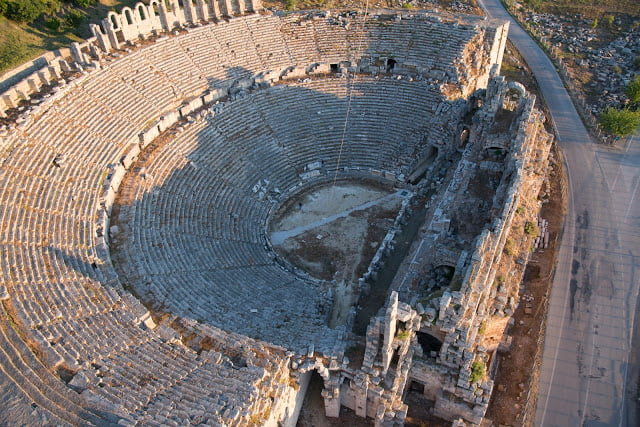Perge Ancient City was the capital city of ancient Pamphylia, which was a former region in the south of Asia Minor, between Lycia and Cilicia. This city, which is taking place on the UNESCO World Temporary Heritage List, is one of the largest and most important ancient cities in Turkey, with its historical assets and size.
Perge is located within the boundaries of the Aksu district of Antalya. It’s just 18 km from Antalya city center.
The Hittites had settlements in this area around 1500 B.C., and St. Paul stopped here on one of his journeys during the time when Perge was an important city of ancient Pamphylia.
Perge is located on a wide plain between the two hills, 4 km west of the Aksu River.
Historical Buildings in Perge Ancient City
Perge has a city plan that is flawless enough to make modern urban planners jealous.
The theater consists of three main sections: Cavea, Orchestra, and Scene. In the theater, there are 19 seats at the bottom and 23 at the top. The orchestra part of the theater is surrounded by railings, so it shows here that gladiator games have been made.
The stage building is the most interesting part of the Perge theater. The stage of the theatre has very nice marble relief work. There are reliefs depicting the life of Dionysus, the god of wine in paintings on the walls of the stage building. On the outer wall is a three-sedioned memorial fountain. Some of the reliefs from the city are displayed in the stadium for easy viewing. Other ruins worth mentioning are the handsome city gate flanked by two lofty towers, a long colonnaded street that was once lined with shops and mosaic pavements, a large agora, and buildings that used to house the baths and gymnasium.
Seventeen monumental statues that were captured from the stage building as a result of archaeological excavations at Perge Theater are exhibited in Perge Theater Hall of Antalya Museum. In addition to this, the Hall of the Gods, the Hall of Emperors, and the Hall of the Sarcophagi of the Antalya Museum consist of artifacts uncovered during the excavations at Perge. Therefore, we recommend you to visit the Antalya Museum after visiting the ancient city of Perge.
To the right of the asphalt road leading from the theater to the city, there is one of the best-preserved stadiums left from ancient times. Perge Stadium is one of the best stadiums from the ancient world to the present day. The stadium has 11 rows of seats resting on 70 belts. It is understood that the belt cavities bearing long edges in the stadium are used as shops.
Agora was the commercial and political center of the city. It is surrounded by shops around the courtyard in the middle of the agora.
Colonnaded Street lies between the ancient fountain (Nymphaeum) and settlements. A 2-meter wide water canal crosses the street in the middle of the street.
Box-Office Summer Opening Time: 08:00
Summer Visit Opening Time: 08:30
Box-Office Summer Closing Time: 19:00
Summer Visit Closing Time: 19:00
Box-Office Winter Opening Time: 08:00
Winter Visit Opening Time: 08:30
Box-Office Winter Closing Time: 16:30
Winter Visit Closing Time: 17:30
Closing Day:
The first day of religious holidays is closed until noon.
Admission Fee: 35 TL
